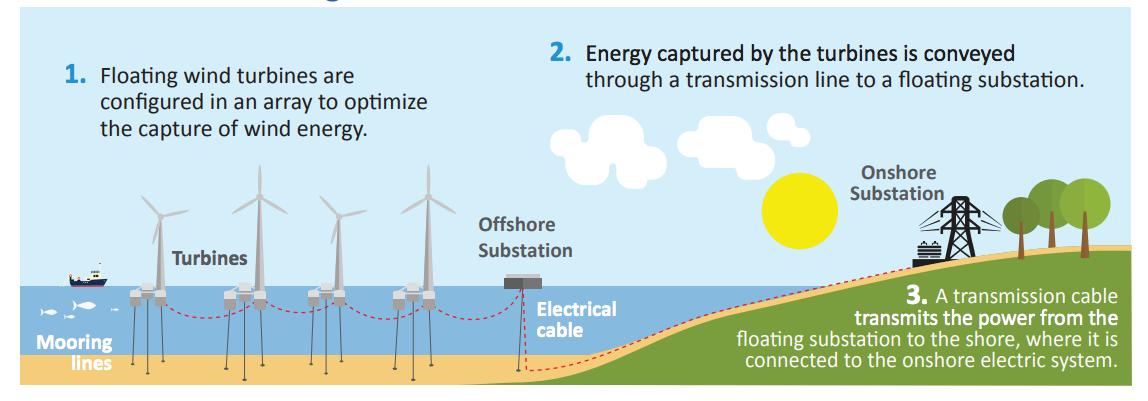
7 minute read
News
Coastal Commission Moves Offshore Wind Forward
As process advances into site studies, commission pushes ‘adaptive management on steroids’
By Thadeus Greenson
thad@northcoastjournal.com How offshore wind works. BOEM
The California Coastal Commission voted unanimously April 7 to conditionally concur with a federal determination that allowing energy companies and organizations to study a proposed offshore wind farm area on the Humboldt County coast is consistent with the state’s Coastal Management Program.
The highly technical and bureaucratic vote clears the way for companies interested in purchasing federal leases to erect large, floating offshore wind turbines to generate renewable electricity off the coast to begin studying and assessing the project site. Known as the Humboldt Wind Energy Area, the site 21 miles off Humboldt Bay spans 132,000 acres, in which the federal Bureau of Ocean Energy Management (BOEM) plans to sell up to three leases in an auction process slated to begin in the fall.
The commission’s vote does not approve the wind farms or the start of any construction activities — all of which would come back before the commission in the future for further review — just lease exploration activities, like site characterization and assessment. Those activities will likely include additional boat trips out to the area — nearly 500 estimated over a three-year period — and the installation of up to three buoys outfitted with scientific sampling equipment.
But commission staff made clear in its report and presentation to the commission that while BOEM believes it is premature to analyze the full scope of environmental impacts of turning a swath of ocean waters off Humboldt Bay into a wind farm, such a transformation is a “reasonably foreseeable” result of the April 7 vote, so should be considered to the extent possible. Further, commission staff explained this consistency determination was a chance to lay a foundation for the commission’s role in the process moving forward as the state and federal governments continue to push for a more sustainable energy grid.
To that end, staff recommended — and the commission approved — seven conditions aimed at mitigating environmental impacts of the site study work, keeping stakeholders involved in the discussion and gathering relevant data.
Condition 1 requires BOEM to work with commission staff to ensure that lessees’ survey, sampling and analysis plans are coordinated to minimize impacts to coastal resources.
Condition 2 requires lessees to avoid “intentional contact” with hard substrate, rock outcroppings, seamounts of deep-sea coral/ sponge habitats, all of which are critical for the region’s biodiversity.
Condition 3 requires vessels conducting site research not exceed a speed of 10 knots to avoid unintentional strikes of sea mammals.
Condition 4 requires BOEM to ensure commercial fishing vessels safe navigation through the lease areas.
Conditions 5 and 6 require engagement with environmental justice communities and Native communities on site assessment and construction and operations plans.
Condition 7 requires lessees to have an independent fisheries liaison to work with the commercial fishing community to make sure site assessment activities don’t conflict with local fisheries.
The overwhelming sentiment of the commissioners was that staff had done an “excellent” job of working with stakeholders and across state and federal agencies to produce a report and recommendations that both properly assessed impacts of the site exploration activities and also set the table for future conversations, all while working under very tight timelines. The final product is “foundational,” commissioners said, representing a “whole of government” approach to evaluating offshore wind.
“California is not only a leader in clean energy in the world, we are a leader in our coastal, wildlife and marine protection, particularly for biodiversity,” Commission Chair Donne Brownsey said. “I think that this is a good start in showing that those two really important goals can be balanced and really work together. I do think that’s where we’re starting and I hope that’s where we can end.”
Perhaps underscoring commissioners’ high praise of staff’s work on its report and recommendations is that they were praised by both environmental and industry groups weighing in on the issue, as well as BOEM.
During her staff report on the subject, Commission Deputy Director of Energy, Ocean Resources and Federal Consistency Kate Huckelbridge noted there are a lot of unknowns with deep-water, floating offshore wind farms but made clear there will be environmental impacts.
“There’s no free lunch,” she said, explaining there will be “tradeoffs” as the state works to triple its clean energy production in the coming decades to achieve the goal of


carbon neutrality by 2045.
Moving forward in the process, Huckelbridge said data collection and “adaptive management” will be crucial components, saying plainly the full-scale impacts of an offshore wind farm on the Pacific Coast won’t be clear until “projects are in the water and we are able to monitor and measure the effects.”
But, Huckelbridge said, the potential impacts of such a project are potentially widespread and would include habitat disturbance, turbine strikes of birds, equipment entanglement of whales and other marine mammals, species displacement, vessel strikes, underwater sound, invasive species and electromagnetic fields. Further, she said the project site includes areas of sensitive habitats that are important for biodiversity, including hard substrate habitats, rocky ridges and sea mounds, as well as deep corals and sponges, all of which might be impacted by the anchoring and mooring of the floating turbine platforms.
Later in the meeting, Huckelbridge noted that commission staff will be working with BOEM to research monitoring programs and technologies as this project moves forward, noting that there are unique challenges associated with carefully documenting impacts that are occurring 21 miles off shore, including those nearly a half-mile under the ocean’s surface.
Commissioner Carly Hart said getting the monitoring and mitigation aspects of the project right are crucial, noting that we face “a biodiversity crisis that’s running parallel to a climate crisis.”
Commissioner Mark Gold said the monitoring that will ultimately be required with the project will be “extraordinary,” noting that there are only 11 of these deep-water floating turbines in the world — stopping to make sure everyone understood he meant 11 turbines, not 11 farms. Doing it successfully, he said, is going to take “adaptive management on steroids.”
“I’ve never seen the coastal commission deal with a project of this scope and scale,” he said, complementing staff on their work.
In his comments at the meeting, Humboldt County Third District Supervisor and Commissioner Mike Wilson underscored that this project could have profound impacts on Humboldt County.
Wilson said that while Humboldt County has a population of just about 140,000 people spread across 4 million acres of land, he noted Humboldt Bay’s outside importance, explaining about 85 percent of the county population lives in communities around the bay. The impacts of this project will be profound, he said, noting these turbines will stand almost 900 feet tall and appear as virtual behemoths that will be serviced or built on Humboldt Bay.
“These structures will be seen from virtually everywhere,” Wilson said, adding the project will undoubtedly bring changes to Humboldt’s natural, cultural and economic ecosystems.
Some of those impacts are exciting, Rob Holmlund, development director for the Humboldt Bay Harbor, Recreation and Conservation District, told the commission.
Holmlund noted that phase 1 of the California offshore wind leases just opens up the areas off Humboldt and Moro bays for farms producing 1.6 and 3.0 gigawatts of electricity, respectively. But plans are in the works to open others, including 6.2 gigawatts of leases off the Mendocino County coast and 6.6 gigawatts of leases in the waters off Del Norte County.
That, coupled with Humboldt Bay’s unique characteristics — being both a deep-water port with unbridged access that would allow passage of structures more than 500 feet tall in and out of the bay — makes Humboldt well suited to potentially become a manufacturing and maintenance hub for these new turbines, which Holmlund said can be “towed very long distances” to their eventual sites. This could put Humboldt County at the forefront of the state’s new “green economy.”
Another thing commissioners and staff repeatedly underscored is the need for all involved with the potential leasing project to work closely with tribes on the North Coast, with Huckelbridge saying it’s “imperative” they benefit. She noted the project’s requirement for the hiring of a tribal liaison to work with the tribes and companies awarded leases, but said that process should focus on “issues of interest to the tribe, not just impacts to cultural resources.”
While many of his commission colleagues spoke effusively about the prospects of offshore wind and the urgency of the moment, Wilson’s comments were more measured, pointing out the need to mitigate negative impacts where possible and come to the table with community benefit agreements that lift up interests that face impacts that ultimately cannot be mitigated.
“We have a community leaning into this — we feel a community and a global responsibility to be a part of this effort to address climate change,” Wilson said, quickly adding that the community’s feet are also “firmly planted” in working to minimize potential negative impacts. “No one is going to roll over us on this. We are taking this really serious.” l
Thadeus Greenson is the Journal’s news editor. Reach him at 442-1400, extension 321, or thad@northcoastjournal.com. Follow him on Twitter @thadeusgreenson.







